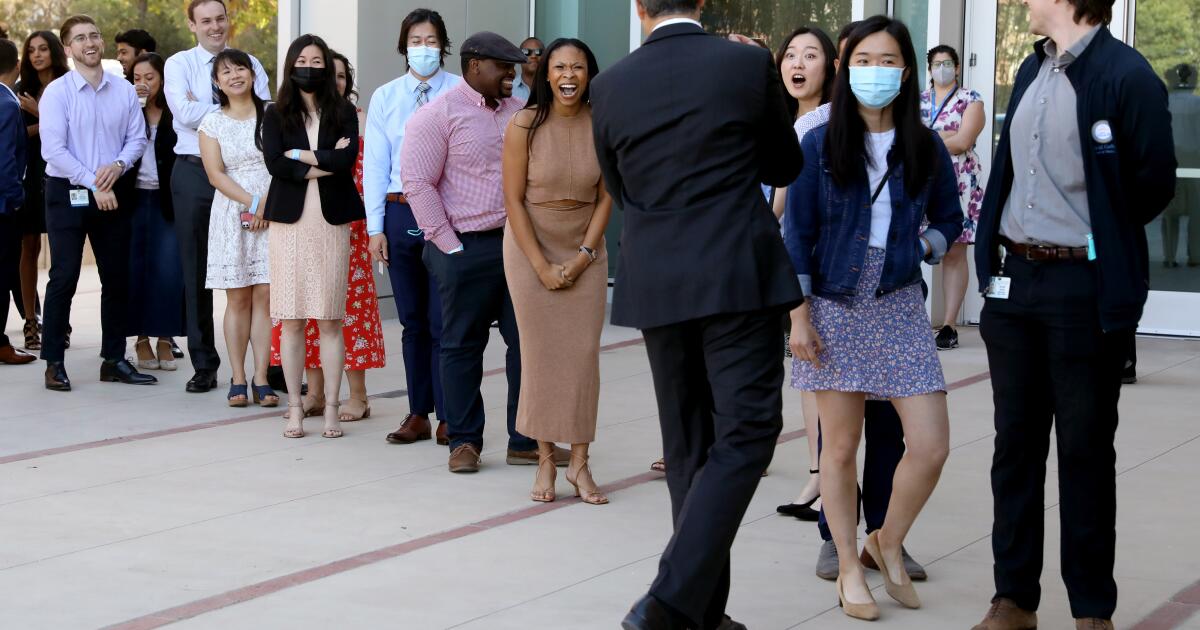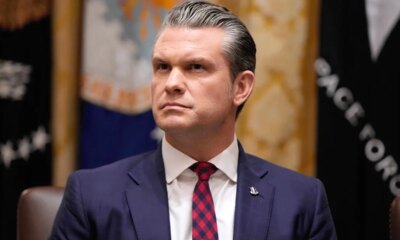Science
Opinion: The evidence shows women make better doctors. So why do men still dominate medicine?

“When will I see the doctor?” Most female doctors have been asked this question many times. It feels like a slight — a failure to recognize the struggle it took to get to where they are, a fight that is far from over once a woman has her medical degree.
Women now make up more than half of medical students but only about 37% of practicing doctors. That is partly because the makeup of the medical workforce lags that of the student body. But it’s also because persistent sexism drives higher attrition among women in medicine.
Even in households headed by a mother and father who both work, the woman is frequently expected to be the primary caretaker. As a result, female physicians often feel forced to work part time, choose lower-paying specialties such as pediatrics or leave the profession altogether.
That’s unfortunate not just for doctors but also for patients. On the whole, female doctors are more empathetic, detail-oriented and likely to follow through than their male counterparts. In other words, they are better doctors.
Admittedly, that is a generalization, but it’s one worth making. I experienced it firsthand working with female colleagues, and I’m informed by that experience in addressing my own medical needs. I prefer to see female doctors.
It wasn’t always that way. But after seeing a series of male doctors who were not listening to me, in a hurry to get out of the exam room or appearing only mildly interested in figuring out the cause of my problem, I made the switch — and I’m not going back. While I found that male doctors typically decided what my diagnosis was and how to treat it before entering the exam room, female doctors tended to be open-minded about what my medical issues were and — gasp! — listen to my answers to their questions.
But don’t take my word for it. Look at the data.
One recent study found that both female and male patients had lower mortality rates when they were treated by female physicians. Perhaps not surprisingly, the benefits of getting care from women were greater for women than for men.
“What our findings indicate is that female and male physicians practice medicine differently, and these differences have a meaningful impact on patients’ health outcomes,” said Yusuke Tsugawa, a senior author of the study.
Female doctors seem more likely to discover the root cause of a medical problem, as we are taught to do in medical school, rather than merely treat the symptoms.
“Female physicians spend more time with patients and spend more time engaging in shared medical decision-making,” Dr. Lisa Rotenstein, a co-author of the study, told Medical News Today. “Evidence from the outpatient setting demonstrates that female physicians spend more time on the electronic health record than male counterparts and deliver higher-quality care. In the surgical realm, female physicians spend longer on a surgical procedure and have lower rates of postoperative readmissions. We need to be asking ourselves how to provide the training and incentives so that all doctors can emulate the care provided by female physicians.”
One reason for the discrepancy might be male doctors’ propensity to be more ego-driven. They may revert to “mansplaining” to patients instead of engaging in an equal, cooperative patient-physician relationship. I’ve been guilty of that myself, so I know it when I see it.
What’s blocking women’s advancement in medicine? Old-fashioned sexism in the workplace is the most obvious answer. Female doctors are paid 25% less than their male counterparts on average, according to the 2019 Medscape Physician Compensation Report, earning an estimated $2 million less over a 40-year career.
There is also a power imbalance. Men are more likely to be full professors at medical schools and presidents of professional medical associations. A 2019 survey found that women oncologists were less likely than their male counterparts to attend scientific meetings because of child care and other demands. And anyone in medicine will attest that these conferences provide opportunities to angle for leadership positions.
Excluding women from leadership deprives young female doctors of role models. While I haven’t seen female doctors being asked to get coffee for their male colleagues (though I have seen women nurses asked to do so, even recently), the unequal distribution of responsibilities is undeniable. Female physicians are often overburdened with menial, uncompensated assignments, secretarial tasks and committee service that does not necessarily lead to promotions, taking precious time away from activities that would be more likely to advance their careers.
These and other factors lead to higher burnout rates among women physicians. A 2022 American Medical Assn. survey found that 57% of female physicians reported suffering at least one symptom of burnout, compared with 47% of men.
“Women physicians are paid less than men, work harder, have less resources, are less likely to be promoted and receive less respect in the workplace,” Roberta Gebhard, a former president of the American Medical Women’s Association, told the Hill. “With all of these barriers to success in the workplace … it’s no wonder that women physicians are more likely to stop practicing than men.”
The patriarchal system is alive and well in medicine, and it isn’t helping our patients. We must address this antiquated disparity. It is incumbent on medical institutions to champion female physicians, not only as rank-and-file doctors but also as leaders of the profession and its organizations. Patients should also examine their own assumptions and challenge the notion that seeing a male doctor will yield better results.
It’s time for doctors to live up to one of the highest ideals of medicine: that all people should be treated equally. That includes female physicians.
David Weill is a physician, a former director of Stanford’s Center for Advanced Lung Disease, the principal of the Weill Consulting Group and the author, most recently, of “All That Really Matters.”

Science
California’s summer COVID wave shows signs of waning. What are the numbers in your community?

There are some encouraging signs that California’s summer COVID wave might be leveling off.
That’s not to say the seasonal spike is in the rearview mirror just yet, however. Coronavirus levels in California’s wastewater remain “very high,” according to the U.S. Centers for Disease Control and Prevention, as they are in much of the country.
But while some COVID indicators are rising in the Golden State, others are starting to fall — a hint that the summer wave may soon start to decline.
Statewide, the rate at which coronavirus lab tests are coming back positive was 11.72% for the week that ended Sept. 6, the highest so far this season, and up from 10.8% the prior week. Still, viral levels in wastewater are significantly lower than during last summer’s peak.
The latest COVID hospital admission rate was 3.9 hospitalizations for every 100,000 residents. That’s a slight decline from 4.14 the prior week. Overall, COVID hospitalizations remain low statewide, particularly compared with earlier surges.
The number of newly admitted COVID hospital patients has declined slightly in Los Angeles County and Santa Clara County, but ticked up slightly up in Orange County. In San Francisco, some doctors believe the summer COVID wave is cresting.
“There are a few more people in the hospitals, but I think it’s less than last summer,” said Dr. Peter Chin-Hong, a UC San Francisco infectious diseases expert. “I feel like we are at a plateau.”
Those who are being hospitalized tend to be older people who didn’t get immunized against COVID within the last year, Chin-Hong said, and some have a secondary infection known as superimposed bacterial pneumonia.
Los Angeles County
In L.A. County, there are hints that COVID activity is either peaking or starting to decline. Viral levels in local wastewater are still rising, but the test positivity rate is declining.
For the week that ended Sept. 6, 12.2% of wastewater samples tested for COVID in the county were positive, down from 15.9% the prior week.
“Many indicators of COVID-19 activity in L.A. County declined in this week’s data,” the L.A. County Department of Public Health told The Times on Friday. “While it’s too early to know if we have passed the summer peak of COVID-19 activity this season, this suggests community transmission is slowing.”
Orange County
In Orange County, “we appear to be in the middle of a wave right now,” said Dr. Christopher Zimmerman, deputy medical director of the county’s Communicable Disease Control Division.
The test positivity rate has plateaued in recent weeks — it was 15.3% for the week that ended Sept. 6, up from 12.9% the prior week, but down from 17.9% the week before that.
COVID is still prompting people to seek urgent medical care, however. Countywide, 2.9% of emergency room visits were for COVID-like illness for the week that ended Sept. 6, the highest level this year, and up from 2.6% for the week that ended Aug. 30.
San Diego County
For the week that ended Sept. 6, 14.1% of coronavirus lab tests in San Diego County were positive for infection. That’s down from 15.5% the prior week, and 16.1% for the week that ended Aug. 23.
Ventura County
COVID is also still sending people to the emergency room in Ventura County. Countywide, 1.73% of ER patients for the week that ended Sept. 12 were there to seek treatment for COVID, up from 1.46% the prior week.
San Francisco
In San Francisco, the test positivity rate was 7.5% for the week that ended Sept. 7, down from 8.4% for the week that ended Aug. 31.
“COVID-19 activity in San Francisco remains elevated, but not as high as the previous summer’s peaks,” the local Department of Public Health said.
Silicon Valley
In Santa Clara County, the coronavirus remains at a “high” level in the sewershed of San José and Palo Alto.
Roughly 1.3% of ER visits for the week that ended Sunday were attributed to COVID in Santa Clara County, down from the prior week’s figure of 2%.
Science
Early adopters of ‘zone zero’ fared better in L.A. County fires, insurance-backed investigation finds

As the Eaton and Palisades fires rapidly jumped between tightly packed houses, the proactive steps some residents took to retrofit their homes with fire-resistant building materials and to clear flammable brush became a significant indicator of a home’s fate.
Early adopters who cleared vegetation and flammable materials within the first five feet of their houses’ walls — in line with draft rules for the state’s hotly debated “zone zero” regulations — fared better than those who didn’t, an on-the-ground investigation from the Insurance Institute for Business and Home Safety published Wednesday found.
Over a week in January, while the fires were still burning, the insurance team inspected more than 250 damaged, destroyed and unscathed homes in Altadena and Pacific Palisades.
On properties where the majority of zone zero land was covered in vegetation and flammable materials, the fires destroyed 27% of homes; On properties with less than a quarter of zone zero covered, only 9% were destroyed.
The Insurance Institute for Business and Home Safety, an independent research nonprofit funded by the insurance industry, performed similar investigations for Colorado’s 2012 Waldo Canyon fire, Hawaii’s 2023 Lahaina fire and California’s Tubbs, Camp and Woolsey fires of 2017 and 2018.
While a handful of recent studies have found homes with sparse vegetation in zone zero were more likely to survive fires, skeptics say it does not yet amount to a scientific consensus.
Travis Longcore, senior associate director and an adjunct professor at the UCLA Institute of the Environment and Sustainability, cautioned that the insurance nonprofit’s results are only exploratory: The team did not analyze whether other factors, such as the age of the homes, were influencing their zone zero analysis, and how the nonprofit characterizes zone zero for its report, he noted, does not exactly mirror California’s draft regulations.
Meanwhile, Michael Gollner, an associate professor of mechanical engineering at UC Berkeley who studies how wildfires destroy and damage homes, noted that the nonprofit’s sample does not perfectly represent the entire burn areas, since the group focused specifically on damaged properties and were constrained by the active firefight.
Nonetheless, the nonprofit’s findings help tie together growing evidence of zone zero’s effectiveness from tests in the lab — aimed at identifying the pathways fire can use to enter a home — with the real-world analyses of which measures protected homes in wildfires, Gollner said.
A recent study from Gollner looking at more than 47,000 structures in five major California fires (which did not include the Eaton and Palisades fires) found that of the properties that removed vegetation from zone zero, 37% survived, compared with 20% that did not.
Once a fire spills from the wildlands into an urban area, homes become the primary fuel. When a home catches fire, it increases the chance nearby homes burn, too. That is especially true when homes are tightly packed.
When looking at California Department of Forestry and Fire Protection data for the entirety of the two fires, the insurance team found that “hardened” homes in Altadena and the Palisades that had noncombustable roofs, fire-resistant siding, double-pane windows and closed eaves survived undamaged at least 66% of the time, if they were at least 20 feet away from other structures.
But when the distance was less than 10 feet, only 45% of the hardened homes escaped with no damage.
“The spacing between structures, it’s the most definitive way to differentiate what survives and what doesn’t,” said Roy Wright, president and chief executive of the Insurance Institute for Business and Home Safety. At the same time, said Wright, “it’s not feasible to change that.”
Looking at steps that residents are more likely to be able to take, the insurance nonprofit found that the best approach is for homeowners to apply however many home hardening and defensible space measures that they can. Each one can shave a few percentage points off the risk of a home burning, and combined, the effect can be significant.
As for zone zero, the insurance team found a number of examples of how vegetation and flammable materials near a home could aid the destruction of a property.
At one home, embers appeared to have ignited some hedges a few feet away from the structure. That heat was enough to shatter a single pane window, creating the perfect opportunity for embers to enter and burn the house from the inside out. It miraculously survived.
At others, embers from the blazes landed on trash and recycling bins close to the houses, sometimes burning holes through the plastic lids and igniting the material inside. In one instance, the fire in the bin spread to a nearby garage door, but the house was spared.
Wooden decks and fences were also common accomplices that helped embers ignite a structure.
California’s current zone zero draft regulations take some of those risks into account. They prohibit wooden fences within the first five feet of a home; the state’s zone zero committee is also considering whether to prohibit virtually all vegetation in the zone or to just limit it (regardless, well-maintained trees are allowed).
On the other hand, the draft regulations do not prohibit keeping trash bins in the zone, which the committee determined would be difficult to enforce. They also do not mandate homeowners replace wooden decks.
The controversy around the draft regulations center around the proposal to remove virtually all healthy vegetation, including shrubs and grasses, from the zone.
Critics argue that, given the financial burden zone zero would place on homeowners, the state should instead focus on measures with lower costs and a significant proven benefit.
“A focus on vegetation is misguided,” said David Lefkowith, president of the Mandeville Canyon Assn.
At its most recent zone zero meeting, the Board of Forestry and Fire Protection directed staff to further research the draft regulations’ affordability.
“As the Board and subcommittee consider which set of options best balance safety, urgency, and public feasibility, we are also shifting our focus to implementation and looking to state leaders to identify resources for delivering on this first-in-the-nation regulation,” Tony Andersen, executive officer of the board, said in a statement. “The need is urgent, but we also want to invest the time necessary to get this right.”
Home hardening and defensible space are just two of many strategies used to protect lives and property. The insurance team suspects that many of the close calls they studied in the field — homes that almost burned but didn’t — ultimately survived thanks to firefighters who stepped in. Wildfire experts also recommend programs to prevent ignitions in the first place and to manage wildlands to prevent intense spread of a fire that does ignite.
For Wright, the report is a reminder of the importance of community. The fate of any individual home is tied to that of those nearby — it takes a whole neighborhood hardening their homes and maintaining their lawns to reach herd immunity protection against fire’s contagious spread.
“When there is collective action, it changes the outcomes,” Wright said. “Wildfire is insidious. It doesn’t stop at the fence line.”
Science
Notorious ‘winter vomiting bug’ rising in California. A new norovirus strain could make it worse

The dreaded norovirus — the “vomiting bug” that often causes stomach flu symptoms — is climbing again in California, and doctors warn that a new subvariant could make even more people sick this season.
In L.A. County, concentrations of norovirus are already on the rise in wastewater, indicating increased circulation of the disease, the local Department of Public Health told the Los Angeles Times.
Norovirus levels are increasing across California, and the rise is especially notable in the San Francisco Bay Area and L.A., according to the California Department of Public Health.
And the rate at which norovirus tests are confirming infection is rising nationally and in the Western U.S. For the week that ended Nov. 22, the test positivity rate nationally was 11.69%, up from 8.66% two months earlier. In the West, it was even worse: 14.08%, up from 9.59%, according to the U.S. Centers for Disease Control and Prevention.
Norovirus is extraordinarily contagious, and is America’s leading cause of vomiting and diarrhea, according to the CDC. Outbreaks typically happen in the cooler months between November and April.
Clouding the picture is the recent emergence of a new norovirus strain — GII.17. Such a development can result in 50% more norovirus illness than typical, the CDC says.
“If your immune system isn’t used to something that comes around, a lot of people get infected,” said Dr. Peter Chin-Hong, an infectious diseases expert at UC San Francisco.
During the 2024-25 winter season, GII.17 overthrew the previous dominant norovirus strain, GII.4, that had been responsible for more than half of national norovirus outbreaks over the preceding decade. The ancestor of the GII.17 strain probably came from a subvariant that triggered an outbreak in Romania in 2021, according to CDC scientists.
GII.17 vaulted in prominence during last winter’s norovirus surge and was ultimately responsible for about 75% of outbreaks of the disease nationally.
The strain’s emergence coincided with a particularly bad year for norovirus, one that started unusually early in October 2024, peaked earlier than normal the following January and stretched into the summer, according to CDC scientists writing in the journal Emerging Infectious Diseases.
During the three prior seasons, when GII.4 was dominant, norovirus activity had been relatively stable, Chin-Hong said.
Norovirus can cause substantial disruptions — as many parents know all too well. An elementary school in Massachusetts was forced to cancel all classes on Thursday and Friday because of the “high volume of stomach illness cases,” which was suspected to be driven by norovirus.
More than 130 students at Roberts Elementary School in Medford, Mass., were absent Wednesday, and administrators said there probably wouldn’t be a “reasonable number of students and staff” to resume classes Friday. A company was hired to perform a deep clean of the school’s classrooms, doorknobs and kitchen equipment.
Some places in California, however, aren’t seeing major norovirus activity so far this season. Statewide, while norovirus levels in wastewater are increasing, they still remain low, the California Department of Public Health said.
There have been 32 lab-confirmed norovirus outbreaks reported to the California Department of Public Health so far this year. Last year, there were 69.
Officials caution the numbers don’t necessarily reflect how bad norovirus is in a particular year, as many outbreaks are not lab-confirmed, and an outbreak can affect either a small or large number of people.
Between Aug. 1 and Nov. 13, there were 153 norovirus outbreaks publicly reported nationally, according to the CDC. During the same period last year, there were 235.
UCLA hasn’t reported an increase in the number of norovirus tests ordered, nor has it seen a significant increase in test positivity rates. Chin-Hong said he likewise hasn’t seen a big increase at UC San Francisco.
“Things are relatively still stable clinically in California, but I think it’s just some amount of time before it comes here,” Chin-Hong said.
In a typical year, norovirus causes 2.27 million outpatient clinic visits, mostly young children; 465,000 emergency department visits, 109,000 hospitalizations, and 900 deaths, mostly among seniors age 65 and older.
People with severe ongoing vomiting, profound diarrhea and dehydration may need to seek medical attention to get hydration intravenously.
“Children who are dehydrated may cry with few or no tears and be unusually sleepy or fussy,” the CDC says. Sports drinks can help with mild dehydration, but what may be more helpful are oral rehydration fluids that can be bought over the counter.
Children under the age of 5 and adults 85 and older are most likely to need to visit an emergency room or clinic because of norovirus, and should not hesitate to seek care, experts say.
“Everyone’s at risk, but the people who you worry about, the ones that we see in the hospital, are the very young and very old,” Chin-Hong said.
Those at highest risk are babies, because it doesn’t take much to cause potentially serious problems. Newborns are at risk for necrotizing enterocolitis, a life-threatening inflammation of the intestine that virtually only affects new babies, according to the National Library of Medicine.
Whereas healthy people generally clear the virus in one to three days, immune-compromised individuals can continue to have diarrhea for a long time “because their body’s immune system can’t neutralize the virus as effectively,” Chin-Hong said.
The main way people get norovirus is by accidentally drinking water or eating food contaminated with fecal matter, or touching a contaminated surface and then placing their fingers in their mouths.
People usually develop symptoms 12 to 48 hours after they’re exposed to the virus.
Hand sanitizer does not work well against norovirus — meaning that proper handwashing is vital, experts say.
People should lather their hands with soap and scrub for at least 20 seconds, including the back of their hands, between their fingers and under their nails, before rinsing and drying, the CDC says.
One helpful way to keep track of time is to hum the “Happy Birthday” song from beginning to end twice, the CDC says. Chin-Hong says his favorite is the chorus of Kelly Clarkson’s “Since U Been Gone.”
If you’re living with someone with norovirus, “you really have to clean surfaces and stuff if they’re touching it,” Chin-Hong said. Contamination is shockingly easy. Even just breathing out little saliva droplets on food that is later consumed by someone else can spread infection.
Throw out food that might be contaminated with norovirus, the CDC says. Noroviruses are relatively resistant to heat and can survive temperatures as high as 145 degrees.
Norovirus is so contagious that even just 10 viral particles are enough to cause infection. By contrast, it takes ingesting thousands of salmonella particles to get sick from that bacterium.
People are most contagious when they are sick with norovirus — but they can still be infectious even after they feel better, the CDC says.
The CDC advises staying home for 48 hours after infection. Some studies have even shown that “you can still spread norovirus for two weeks or more after you feel better,” according to the CDC.
The CDC also recommends washing laundry in hot water.
Besides schools, other places where norovirus can spread quickly are cruise ships, day-care centers and prisons, Chin-Hong said.
The most recent norovirus outbreak on a cruise ship reported by the CDC is on the ship AIDAdiva, which set sail on Nov. 10 from Germany. Out of 2,007 passengers on board, 4.8% have reported being ill. The outbreak was first reported on Nov. 30 following stops that month at the Isle of Portland, England; Halifax, Canada; Boston; New York City; Charleston, S.C.; and Miami.
According to CruiseMapper, the ship was set to make stops in Puerto Vallarta on Saturday, San Diego on Tuesday, Los Angeles on Wednesday, Santa Barbara on Thursday and San Francisco between Dec. 19-21.
-

 Alaska1 week ago
Alaska1 week agoHowling Mat-Su winds leave thousands without power
-

 Texas1 week ago
Texas1 week agoTexas Tech football vs BYU live updates, start time, TV channel for Big 12 title
-

 Washington5 days ago
Washington5 days agoLIVE UPDATES: Mudslide, road closures across Western Washington
-

 Iowa1 week ago
Iowa1 week agoMatt Campbell reportedly bringing longtime Iowa State staffer to Penn State as 1st hire
-

 Miami, FL1 week ago
Miami, FL1 week agoUrban Meyer, Brady Quinn get in heated exchange during Alabama, Notre Dame, Miami CFP discussion
-

 Cleveland, OH1 week ago
Cleveland, OH1 week agoMan shot, killed at downtown Cleveland nightclub: EMS
-

 Iowa1 day ago
Iowa1 day agoHow much snow did Iowa get? See Iowa’s latest snowfall totals
-
World7 days ago
Chiefs’ offensive line woes deepen as Wanya Morris exits with knee injury against Texans


















